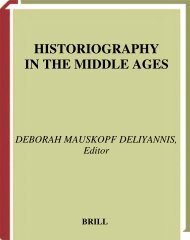Medieval Sexuality: A Casebook - Julian Emperor
Medieval Sexuality: A Casebook - Julian Emperor
Medieval Sexuality: A Casebook - Julian Emperor
You also want an ePaper? Increase the reach of your titles
YUMPU automatically turns print PDFs into web optimized ePapers that Google loves.
34 Dominic JanesThe rise of the penitentials was not directed by any central authority. Itappears that these texts were based upon a codification of customary practice,bearing in mind the general guidance given in the Bible as to what counted assin in passages such as Acts 15: 39, Mark 7: 21–2, Galatians 5: 19–21 and Revelation21: 8. The idea of the deadly sins was particularly propagated in the westthrough John Cassian (c.360–433 AD) and his Conferences, wherein he listedgluttony, fornication, avarice, anger, dejection, languor, vainglory and pride. 6The detailed nature of the penitentials prompted medievalist Nora Chadwick toclaim that these texts were “webs spun in the casuistry of the monkish brain. Theyform an abstract compendium of suppositious crimes and unnatural sins, thoughtup in the cloister by the tortuous intellect of the clerical scribe.” 7 The variety anddepth of description of the individual sins varied, though of these categories,fornication was the most prominent in terms of percentage of words in the earlymedieval texts. The rise of concern with sexual purity from St Paul throughLate Antiquity has been charted in many works, as for instance in Peter Brown’s,The Body and Society. 8 The tenor of the penitentials is overwhelmingly negativetowards any deviation from vaginal intercourse in the male-superior position, andagainst any sex outside wedlock. However, the fact that such admirable churchmenwould engage in the writing of such sexually detailed documents, regardlessof their tone or treatment of the subject, seemed to be sufficiently abhorrent tolater commentators to warrant the harsh editing or total exclusion of the worksfrom the collected works of several theologians. For example, when preparing acollection of the works by the venerable Bede, Plummer did not edit thepenitentials. He justified his exclusion by asserting that the penitential ascribedto Bede was not by him and thus should not be included in his edition. Plummerstates that: “the arguments are against Bede’s authorship, and we should bethankful to believe that Bede had nothing to do with such a matter.” 9 If theseearly texts showed enthusiasm for sexuality, especially “deviant” sexuality, thenegative view of scholars would be easier to understand. But this is not the case.The texts are impeccably dour.Of serious concern for Plummer and his successors was the direct languageof the texts, which we can best appreciate by looking at the twentieth-centuryattempts to engage with what Plummer left in silence. This was still giving majorproblems to translators and editors into the second half of the twentieth century,as for instance in the major edition of the Irish penitentials published by Bielerin 1963, which can be compared with the translations of McNeill and Gamerof 1938. It is a feature of the translations of the texts, as Frantzen has shown, tobowdlerize, ignore or fail to translate “difficult” sections. 10 For example, comparethe original text of the Old Irish Penitential below, found in RIA (Royal IrishAcademy) 3 B23, a fifteenth-century manuscript now in Dublin, to the translationsby Bieler and McNeill and Gamer. In many cases throughout the penitential,Binchy in Bieler translates the text into English, except for sexual matters thatare translated into Latin (sections 2, 11–35). 11 McNeill and Gamer announce they













